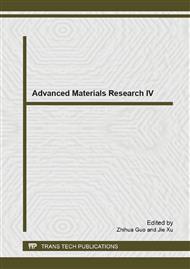p.349
p.355
p.360
p.364
p.369
p.374
p.381
p.386
p.391
Preparation of Poly(vinyl alcohol)/Polyoxalate Composite Nanofibers by Electrospinning and Drug Release Profiles
Abstract:
This study investigated the use of a biodegradable polyoxalate blended with poly (vinyl alcohol) nanofibers to tailor properties of nanofibers and to control release of Rhodamine B from nanofibers. Nanofibers were prepared using an electrospinning technique. The morphology and average diameter of electrospun nanofibers were investigated using scanning electron microscopy. It was found that poly (vinyl alcohol) to polyoxalate ratio had a significant effect on the size of nanofibers (~175-403 nm). An in vitro release study showed that rate of Rhodamine B release increased with increasing poly (vinyl alcohol)/polyoxalate ratios yielding rate of release in the range of 0.1980.469 mg%/min. The mechanism of rhodamine B release can be explained by a two-stage process of diffusion and degradation. The results suggested that a water-insoluble polyoxalate could govern the rate of drug release. The ability to tune the release of chemicals from nanofibers has significant implications for controlled release of drugs.
Info:
Periodical:
Pages:
369-373
Citation:
Online since:
February 2014
Keywords:
Price:
Сopyright:
© 2014 Trans Tech Publications Ltd. All Rights Reserved
Share:
Citation:


